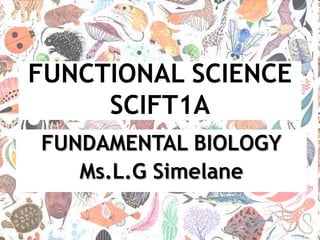
Fundamental Biology: Properties of Water
- 2. Clitheroe, F & Dilley, L. (2010), Natural Sciences Learner’s Book, Grade 9. Oxford University Press. ISBN: 9780195762945
- 3. UNIT 1: THE ROLE OF WATER
- 4. Water is a chemical substance with the chemical formula H2O. Its molecule contains one oxygen and two hydrogen atoms connected by covalent bonds. Water molecules are connected by Hydrogen bonds.
- 6. The polarity of water molecules results in hydrogen bonding • Water = unique properties that allows it to support & maintain living systems • – Due to its structure & interaction with other molecules • The water molecule is a polar molecule: The opposite ends have opposite charges Polarity allows water molecules to form hydrogen bonds with each other Copyright © 2008 Pearson Education, Inc., publishing as Pearson Benjamin Cummings
- 7. Fig. 3-2 Hydrogen bond – H + H O + + + – – – Slightly + H of 1 molecule attracted to slightly – O of nearby molecule – Hydrogen bond keeps them together. In liq water the bond is very weak - Continually reforming & breaking
- 8. Four properties of water contribute to Earth’s fitness for life • 4 of water’s properties that facilitate an environment for life are: 1. Cohesive behavior (predictable behavior) 2. Ability to moderate temperature 3. Expansion upon freezing 4. Versatility as a solvent (dissolve various substances) Copyright © 2008 Pearson Education, Inc., publishing as Pearson Benjamin Cummings
- 9. ¾ of the Earth’s surface is covered by water of the oceans. Every cell consists of 50 – 90% water. Needed to transport molecules in & out cells. Many organisms live in water.
- 10. Water can be found in 3 phases: 1. Gasses 2. Liquids 3. Solids
- 11. Consist of water molecules that move around freely: A lot of energy and space between molecules. Attraction between molecules very weak. Called water vapour. Found in atmosphere.
- 12. When temperature increases, it causes liquid water to change to water vapour (evaporate).
- 13. Water molecules move around less than gasses but more than solids. More energy than solids but less than gas. Attraction forces between molecules is stronger than gas molecules but weaker than solids. It takes on the shape of the container it is in. Found everywhere. If solid water is heated, liquid water forms.
- 14. Solid water molecules are called ice. Molecules only vibrate at one spot. Minimal amount of energy but very strong attraction forces between molecules. Molecules arrange in a structured way called a crystal lattice. Found everywhere. If liquid water is cooled down it becomes a solid.
- 16. Water has a high heat capacity Amount of heat required to raise the temperature of 1g of water by 1˚C. Prevents water from freezing or boiling if atmospheric temperature changes protecting aquatic organisms. Water has a high heat of evaporation Amount of heat required to vaporize a liquid. Helps animals, they sweat, water evaporates when they overheat, to cool them down. Water has a high heat of fusion Amount of heat required to melt a solid.
- 18. More things can dissolve in water than any other liquid. The liquid that a substance dissolves in is called a solvent. Blood contains 55% water called blood plasma. Gasses have to dissolve in the blood plasma and then diffuse into the red blood cells to transport the oxygen to the body cells and and carbon dioxide to the lungs.
- 20. All chemical reactions to control metabolism take place in water. E.g. Digestion, breathing etc. Water takes part in some chemical reactions e.g. Photosynthesis What is photosynthesis? The process whereby plants use water, sunlight and carbon dioxide to produce food and oxygen. Enzymes speed up chemical reactions in the presence of water.
- 21. Water helps transport substances in the body of a plant or animal: E.g. In humans, food and gasses are transported via the blood circulatory system (consisting of mainly water). E.g. In plants, mineral salts, absorbed from the soil are dissolved in water and carried to all parts of the plant.
- 22. Most organisms need water to reproduce. Mosses and ferns can only reproduce if they are covered with a thin film of water. All animals need water to reproduce, the sperm needs water to swim to the ova (egg cell). Aquatic animals reproduce in the water.
- 23. Vertebrates (like humans)have a bony skeleton to support the shape of their bodies. Invertebrates do not consist of bones, most of them have water that helps to support the body shape, called a hydrostatic skeleton. Water pushes against the sides of the body, exerting pressure to maintain the shape. E.g. Worms and snails. Xylem tubes together with water helps plants stay upright. (Think about a plant deprived of water)
- 24. Humans use “water” to cool down. This water is known as sweat. (perspiring) Sweat is produced by sweat glands. When the sweat evaporates from the body, it cools down. This happens during strenuous exercise, stress and illness.
- 25. Plants lose water through their leaves. Process of transpiration. Transpiration helps to cool the plant down. What is transpiration? Loss of water in the form of water vapour through openings called stomata, on the leaves of plants. Helps plants suck water up stem to leaves STOMATA Cross section through leaf to see
- 26. Cover pot plant/branch of plant with a plastic bag Seal bag with a string. Leave bag for few hours. Observe Result: Water droplets form on the sides of the plastic bag. What happened? Transpiration occurred You can try this at home
